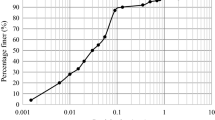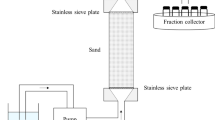Abstract
Background, Aims and Scope
Surfactant enhanced ex-situ soil washing can be used to remediate diesel contaminated soils. Surfactants enhance the diesel removal from soils by two processes: mobilization and solubilization. Mobilization occurs at surfactant concentrations below the critical micelle concentration (CMC), while solubilization occurs at surfactant concentrations beyond the CMC of the surfactant. In this paper, the leaching of diesel from a self contaminated (10 000 mg diesel/kg) sandy-loam soil was studied using low concentrated non-ionic surfactant solutions of Tergitol NP-10 (10-6 to 10-3 mol/L).
Methods
The surface tension of the supernatant solutions of soil suspensions in non-ionic surfactant (Tergitol NP-10) solutions (10-6 to 10-3 mol/L) was measured to determine the total surfactant concentration (surfactant sorbed onto the soil + surfactant in solution) at which micelles are present in the water phase of the soil suspension, or 'effective critical micelle concentration' (ECMC), and to calculate the sub-CMC sorption isotherm of Tergitol NP-10 onto the soil. The diesel removal was measured by soil leaching experiments with Tergitol solutions ranging from 10-6 to 10-3 mol/L.
Results and Discussion
The sub-CMC sorption isotherm of Tergitol onto the soil could be described by the Freundlich equation. Even at very low surfactant concentrations (10-6 mol/L) the surfactant enhanced the diesel removal from the soil. Up to the surfactants' ECMC the diesel removal increased in a linear way with an increasing surfactant concentration in the wash water. A significant part (20%) of the diesel oil was removed in the presence of surfactant, but in absence of micelles. Beyond the surfactants' ECMC, the increase in diesel removal efficiency with increasing surfactant concentration was less pronounced. When the added surfactant concentration was increased to 10-3 mol/L, which corresponds to an equilibrium surfactant concentration in the supernatant solution (6.77.10-4 mol/L) above the CMC, the diesel oil removal was increased up to 50%. At this surfactant concentration emulsion formation was observed.
Conclusion
Surfactant aided leaching of diesel from a self-contaminated, sandy-loam soil with surfactant solutions below their ECMC was able to remove in one step 20% of diesel from the soil by the mobilization mechanism. Succesive treatments or continuous leaching with surfactant solutions below their ECMC was not studied but is likely to reduce the diesel contamination further and at the same time avoid problems with emulsion formation.
Similar content being viewed by others
Author information
Authors and Affiliations
Corresponding authors
Rights and permissions
About this article
Cite this article
Vreysen, S., Maes, A. Remediation of a Diesel Contaminated, Sandy-Loam Soil Using Low Concentrated Surfactant Solutions (5 pp). J Soils Sediments 5, 240–244 (2005). https://doi.org/10.1065/jss2005.10.146
Received:
Accepted:
Published:
Issue Date:
DOI: https://doi.org/10.1065/jss2005.10.146




